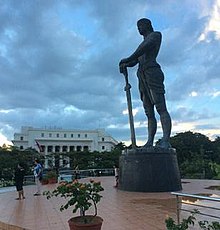Loading AI tools
Monument to Lapu-Lapu in Manila, Philippines From Wikipedia, the free encyclopedia
The Statue of the Sentinel of Freedom or the Lapu Lapu Monument is a monument to Lapulapu formerly located at the center of the Agrifina Circle at Rizal Park in Manila, Philippines.[1]
 The statue in 2016 on top of the podium within the Agrifina Circle | |
 | |
| 14°35′03″N 120°58′53″E | |
| Location | Rizal Park, Manila |
|---|---|
| Designer | Juan Sajid Imao |
| Material | Bronze |
| Height | 12.19 meters (40.0 ft) (including 3.05-meter (10.0 ft) pedestal) |
| Opening date | February 5, 2004 |
| Dedicated to | Lapulapu |


In 2004, House of Representatives members Raul del Mar (Cebu City–1st) and Nerissa Corazon Soon-Ruiz (Cebu–6th) initiated the installation of a statue of Lapulapu in Rizal Park as a move to honor Lapulapu as a hero of not only Cebu but the whole Philippines.[2] They urged the Office of the President to accept their proposal.[3] Then-tourism Secretary Richard Gordon, who was a 2004 senatorial candidate,[4] supported the installation of the statue.[5] The project was opposed by the National Historical Institute (NHI) led by Ambeth Ocampo, which insist that only statues of heroes of the Philippine Revolution could be erected in the Agrifina Circle.[6]
The statue was unveiled on February 5, 2004, despite opposition from the NHI, after then President Gloria Macapagal Arroyo greenlit the move.[6] The Korean Freedom League led by Chairman Kwon Jung-dal[1] donated ₱15 million for the casting of the statue.[7] The statue was momentarily dismantled from the Agrifina Circle sometime in mid-2004, which was met with opposition including the local government of Lapu-Lapu City at that time.[6]
In 2014, Lapu-Lapu City Mayor Paz Radaza requested the transfer of the statue to Punta Engaño in her city, where she plans to put it on an island to be made at the tip of the locality. This proposal came up after Radaza met with Tourism Secretary Ramon Jimenez Jr. where the National Historical Institute's (NHI) opinion that the statue could "desecrate" Rizal Park was brought up.[2] The move was opposed by Representative Raul del Mar, who said that the move would be detrimental and will cause a “loss of honor and recognition” to the province and Cebu and Lapu-Lapu.[3]
In July 2023, the statue was taken under the care of the National Museum of the Philippines and was dismantled for “restoration and re-erection,” amidst the redevelopment of the park's eastern section.[8][9] The re-erection project was completed in August 2024.[10]
The Statue of the Sentinel of Freedom and was designed by sculptor Juan Sajid Imao. The monument is composed of a 12.19-meter (40.0 ft) bronze statue on-top of a 3.05-meter (10.0 ft) pedestal. Imao noted that his work on the statue seeks to portray Lapulapu as a strong and peace-loving man who is also ready to defend himself against those who threaten his freedom. Lapulapu is portrayed not in a fighting stance but rather standing guard holding a kampilan covered in scabbard and planted on the ground.[1]
Then Tourism Undersecretary Oscar Palabyab chose to create a statue for Lapulapu not primarily due to his victory over Ferdinand Magellan but the value he stands for in history.[1]
The distance between the statue and the Rizal Monument, which is dedicated to Jose Rizal, is 400 feet (120 m), representing the "400-year gap" between Lapulapu and Rizal.[4] According to Gordon, Lapulapu represents the Muslims and Rizal represents the Tagalog-Christians in Philippine history.[7]
The statue which was also donated by the Korean Freedom League was a gift in recognition for Filipinos who fought for South Korea in the Korean War.[3]
Seamless Wikipedia browsing. On steroids.
Every time you click a link to Wikipedia, Wiktionary or Wikiquote in your browser's search results, it will show the modern Wikiwand interface.
Wikiwand extension is a five stars, simple, with minimum permission required to keep your browsing private, safe and transparent.